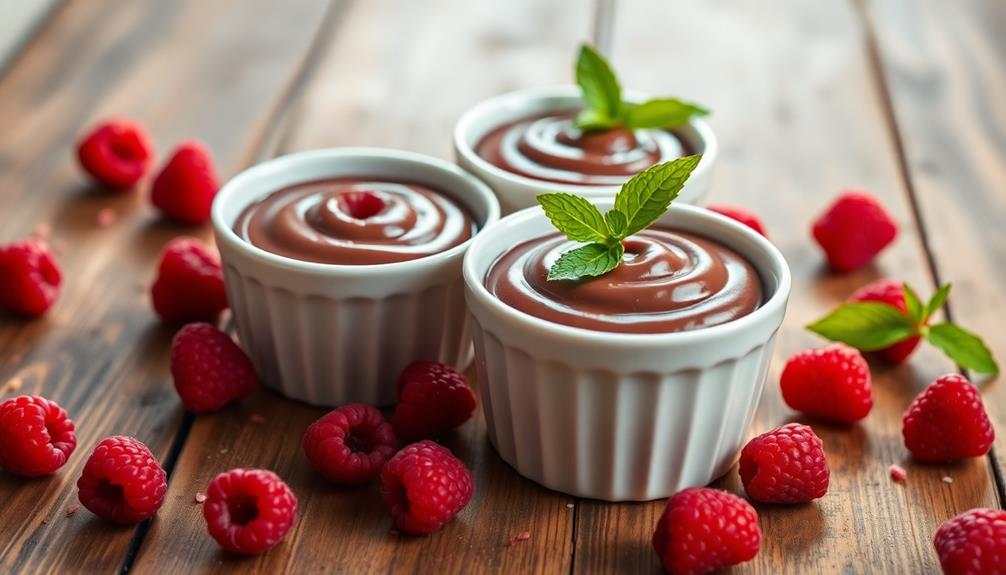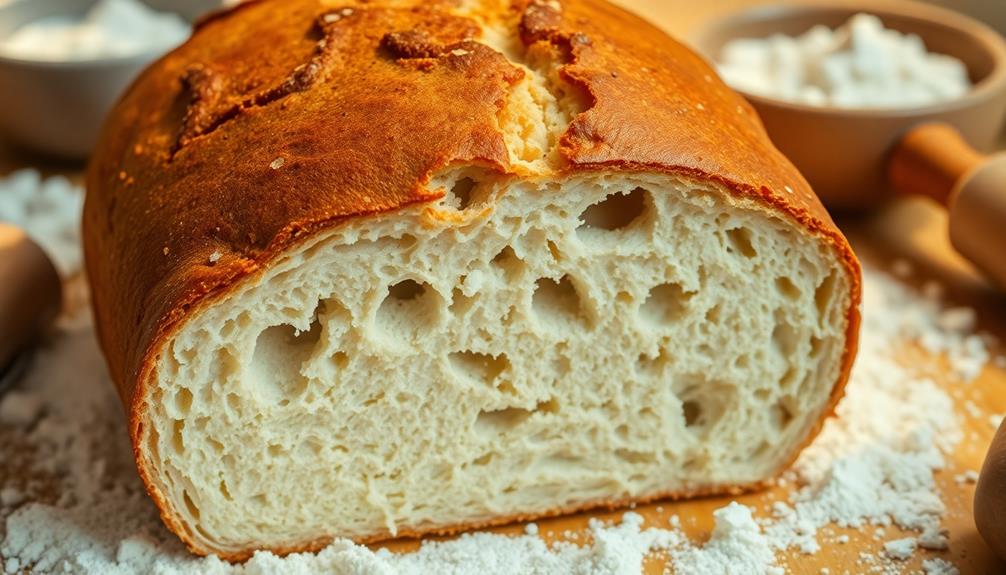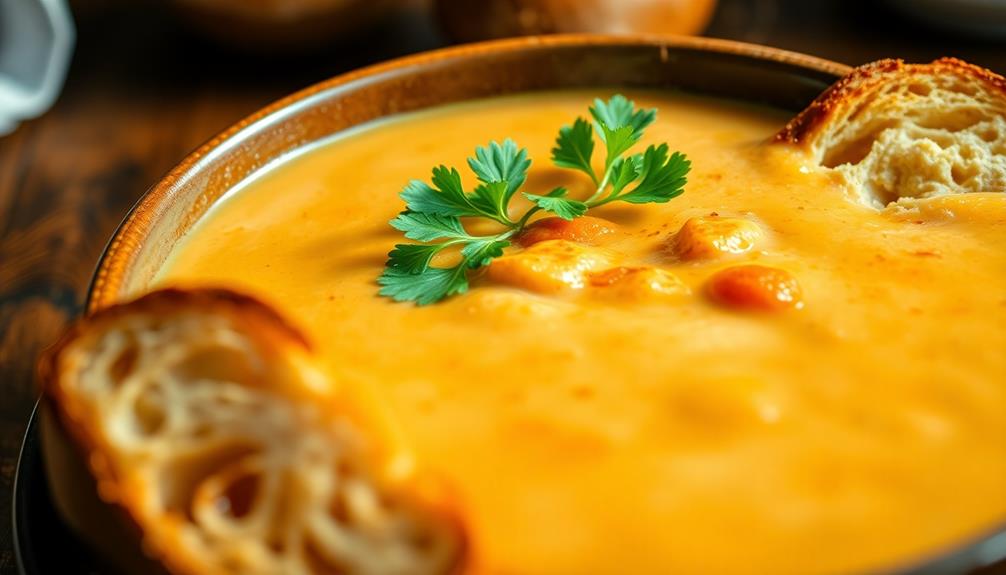Embracing a gluten-free lifestyle doesn't mean giving up on delicious breakfast options. You'll find a wealth of nutritious and satisfying choices to start your day right. Explore the versatility of gluten-free grains like quinoa and rice, combine them with fresh fruits and vegetables, and add a protein boost from eggs, nuts or seeds. Get creative with gluten-free flour blends for baked treats like banana bread or fluffy pancakes. By keeping a well-stocked pantry and planning ahead, you can enjoy satisfying gluten-free breakfasts that energize your day. There's more to discover about this rewarding culinary journey.
Key Takeaways
- Gluten-free breakfast options provide essential nutrients and energy to start the day, promoting better health outcomes and digestive well-being.
- A wide variety of gluten-free grains, fruits, vegetables, and protein sources can be incorporated into creative and satisfying breakfast meals.
- Effective mixing and preparation of gluten-free flour blends, wet ingredients, and baking steps ensure the successful execution of gluten-free baked goods.
- Meal prepping and maintaining a well-stocked gluten-free pantry can simplify the process of planning and preparing delicious gluten-free breakfasts.
- Exploring new gluten-free breakfast recipes and utilizing seasonal ingredients can enhance the overall enjoyment and nutrition of the morning meal.
History
Although gluten-free eating has existed for centuries, it only gained widespread popularity in the late 20th century. Many people discovered they'd sensitivities to gluten, a protein found in wheat, rye, and barley. As a result, the demand for gluten-free foods skyrocketed.
Researchers also uncovered the autoimmune condition celiac disease, which requires a strict gluten-free diet. Today, gluten-free living is more accessible than ever, with a wealth of products and recipes available.
The history of this dietary approach is rooted in helping people manage health issues, from digestive problems to autoimmune disorders. With increased awareness and understanding, the gluten-free lifestyle continues to evolve, offering more delicious and nutritious breakfast options for everyone to enjoy.
As you explore the world of gluten-free eating, you'll discover a range of tasty and satisfying ways to start your day right.
Recipe
Gluten-Free Banana Bread
Banana bread is a classic breakfast treat that can easily be made gluten-free. This recipe uses a blend of gluten-free flours to create a tender and moist loaf, perfect for a satisfying start to the day. The natural sweetness of ripe bananas takes center stage, complemented by the warm spices of cinnamon and vanilla.
This recipe is also versatile, allowing you to customize it to your liking. Feel free to add chopped nuts, chocolate chips, or a streusel topping for an extra special touch.
Ingredients:
- 1 1/2 cups gluten-free all-purpose flour
- 1/2 cup almond flour
- 1 teaspoon baking soda
- 1/2 teaspoon ground cinnamon
- 1/4 teaspoon salt
- 3 ripe bananas, mashed
- 1/2 cup maple syrup
- 1/4 cup unsweetened applesauce
- 2 large eggs
- 1 teaspoon vanilla extract
Preheat your oven to 350°F (175°C). Grease a 9×5-inch loaf pan with non-stick cooking spray or line it with parchment paper.
In a medium bowl, whisk together the gluten-free all-purpose flour, almond flour, baking soda, cinnamon, and salt. In a separate bowl, mash the ripe bananas and then stir in the maple syrup, applesauce, eggs, and vanilla extract until well combined.
Gradually mix the dry ingredients into the wet ingredients, being careful not to overmix. Pour the batter into the prepared loaf pan and bake for 50-60 minutes, or until a toothpick inserted into the center comes out clean.
Allow the banana bread to cool in the pan for 10 minutes before transferring it to a wire rack to cool completely.
To ensure the best texture, be sure not to overmix the batter, as this can result in a dense and dense loaf. Additionally, use ripe, spotty bananas for optimal sweetness and moisture.
Enjoy your gluten-free banana bread with a smear of nut butter, a drizzle of honey, or simply on its own.
Cooking Steps
First, you'll want to mix the gluten-free flour ingredients together in a bowl.
Next, add the wet ingredients and fold in the gluten-free baking powder.
Step 1. Mix Gluten-Free Flour Ingredients
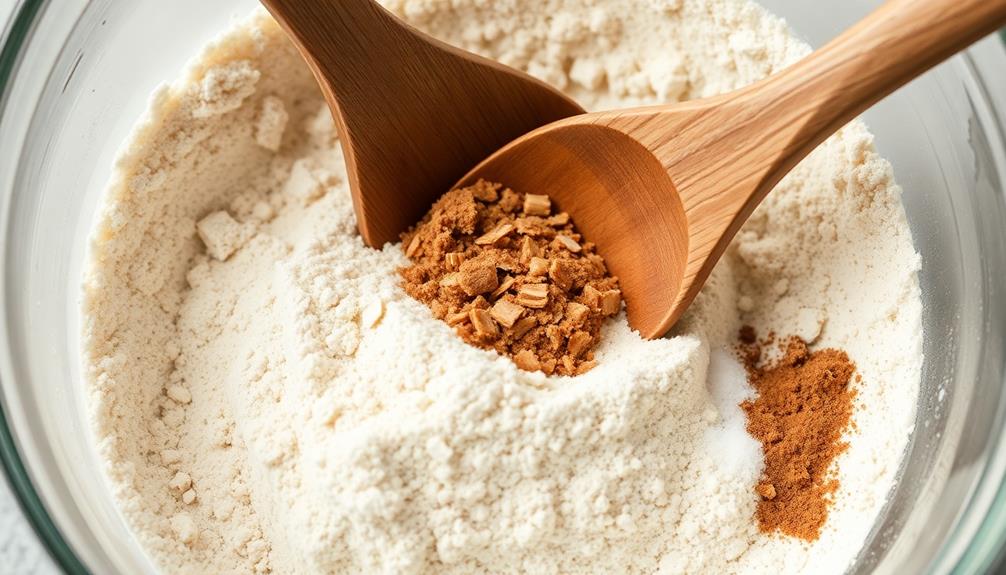
Mixing your own gluten-free flour blend is a simple task that allows you to customize the texture and flavor to your liking.
Start by gathering your ingredients, which may include a combination of gluten-free flours like rice flour, tapioca flour, and almond flour. You can also add a pinch of xanthan gum to help bind the ingredients together.
Measure out the amounts of each flour you'd like to use, then pour them into a large mixing bowl. Use a whisk to thoroughly combine the dry ingredients until they're evenly distributed. This step ensures your baked goods will have a consistent texture throughout.
Once the flour blend is mixed, you can store it in an airtight container for future use. When you're ready to bake, simply measure out the amount of flour your recipe calls for.
This homemade blend will give your gluten-free dishes a delicious, customized taste and texture.
Step 2. Add Wet Ingredients

Now that you've mixed your own gluten-free flour blend, you can start adding the wet ingredients to your recipe. The key is to slowly incorporate the liquids into the dry flour mix.
Begin by cracking a couple of eggs into a separate bowl. Whisk them together until they're nicely blended.
Next, measure out the milk or dairy-free milk alternative you'll be using. Pour it in gradually, while continuously stirring the batter. Don't be afraid to get in there with a whisk to ensure there are no lumps.
Finally, add a splash of vanilla extract or any other wet ingredients your recipe calls for. Stir everything together until you've got a smooth, pourable consistency.
Now you're ready to start cooking up those gluten-free breakfast treats! Just remember to adjust the ratios if you need a thicker or thinner batter. With a little practice, you'll be a pro at adding the perfect amount of wet ingredients.
Step 3. Fold in Gluten-Free Baking Powder

Folding in the gluten-free baking powder is a crucial step in creating the perfect rise and texture for your breakfast treats. This special powder acts as a leavening agent, reacting with the wet ingredients to produce tiny air bubbles that lighten up your batter.
For a delicious start to your day, consider pairing your breakfast with options like Keto Breakfast With Eggs that offer high protein and low carbohydrates.
Be gentle but thorough when you fold it in – you don't want to over-mix and deflate all that airy goodness.
Start by sifting the baking powder into your dry ingredients. This helps it distribute evenly.
Then, use a rubber spatula to gently fold the powder into the wet batter, making sure not to overmix. Fold just until you no longer see any dry pockets – any more and you risk a dense, flat result.
The key is a light touch to preserve all that air you've worked hard to build up. Fold with care, and you'll be rewarded with fluffy, gluten-free breakfast perfection.
Step 4. Cook Until Golden Brown

Cooking your gluten-free breakfast treats to a perfect golden-brown hue is the final step in achieving that irresistible texture and flavor. Keep a close eye on your baked goods as they near the end of the cooking time, watching for that beautiful golden-brown color to develop. This is the sweet spot – any longer in the oven, and you risk burning or drying out your creation.
Use the oven light to peek in and check the progress, and resist the temptation to open the oven door too often, as this can affect the even cooking. When the edges start to turn golden and the center is no longer wet or doughy, your gluten-free breakfast is ready.
Carefully remove the pan or baking dish from the oven, allowing the items to cool slightly before serving. With a perfectly cooked, golden-brown exterior, your gluten-free breakfast will be a delight to both the eyes and the taste buds.
Step 5. Serve Warm With Desired Toppings
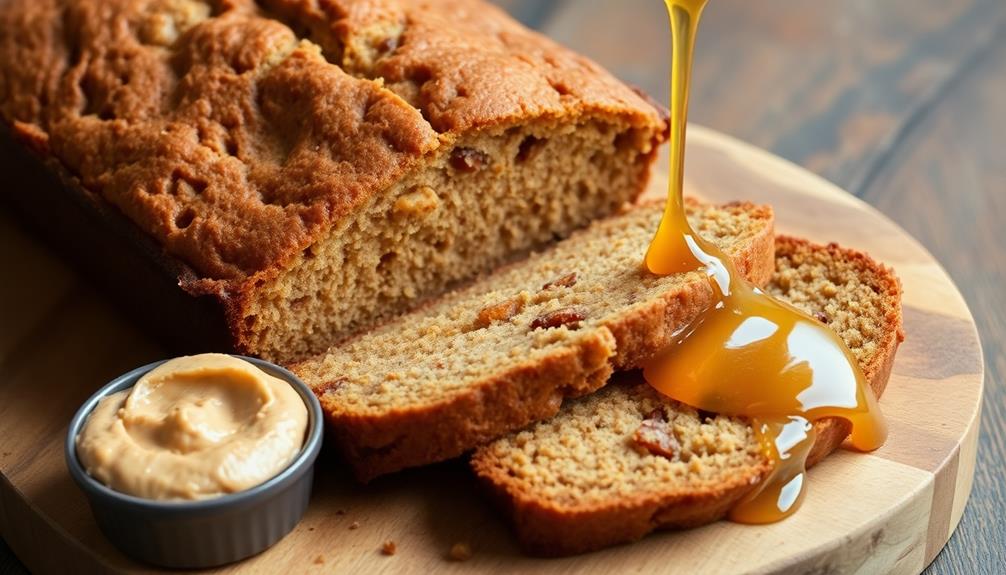
With your gluten-free breakfast now perfectly cooked to that golden-brown finish, it's time to serve it up warm and ready to enjoy. Carefully transfer your dish to a serving plate or bowl, ensuring it's piping hot.
Top it with your choice of delicious, gluten-free garnishes. Sliced bananas, fresh berries, a sprinkle of cinnamon, or a drizzle of maple syrup can all add a tasty touch. For an extra flavor boost, consider adding elements like a rich cinnamon sugar blend or even a dollop of creamy whipped ricotta.
Don't be afraid to get creative and experiment with different flavor combinations. The possibilities are endless!
Once your breakfast is adorned with your preferred toppings, it's time to dive in. Grab a fork and savor each bite, letting the warm, comforting flavors melt in your mouth.
As you enjoy your meal, take a moment to appreciate the hard work and care you've put into preparing a nourishing, gluten-free start to your day. Fuel up and get ready to tackle whatever the day has in store. Be proud of yourself for taking the time to prioritize your health and well-being by choosing a gluten-free meal. Whether you carefully planned this glutenfree meal prep or threw something together on the fly, give yourself credit for making a conscious decision to fuel your body with nutritious and gluten-free food. Embrace the positive energy and nutrients from this meal as you go about your day.
Final Thoughts
Ultimately, a gluten-free breakfast can be both nutritious and satisfying. You don't have to sacrifice taste or convenience to enjoy a healthy start to your day.
With the wide variety of gluten-free options available, you can easily create meals that are both delicious and gluten-free.
Remember, the key to a successful gluten-free breakfast is to plan ahead and have the right ingredients on hand. Experiment with different recipes and find what works best for your taste preferences and dietary needs.
Don't be afraid to get creative and try new things – you might just discover a new favorite gluten-free breakfast dish.
Ultimately, a gluten-free breakfast can be a delightful and rewarding experience. By focusing on fresh, whole-food ingredients, you can enjoy a meal that nourishes your body and satisfies your taste buds.
Frequently Asked Questions
What Are the Benefits of a Gluten-Free Breakfast?
Choosing a gluten-free breakfast can provide numerous benefits. It helps manage digestive issues, reduces inflammation, and promotes overall health. Plus, it offers a variety of tasty and nutritious options to start your day off right.
How Can I Ensure My Gluten-Free Breakfast Is Nutritious?
To ensure your gluten-free breakfast is nutritious, focus on including a balance of protein, healthy fats, complex carbs, and fiber-rich foods. Choose whole, minimally processed ingredients and pair them for a nourishing start to your day.
Can I Substitute Regular Flour for Gluten-Free Flour in Recipes?
You can substitute regular flour for gluten-free flour, but it won't work the same way. Gluten-free flours have different properties, so the recipe may not turn out as expected. It's best to use gluten-free flour specifically designed for the recipe.
How Long Do Gluten-Free Breakfast Items Typically Last?
Gluten-free breakfast items typically have a shorter shelf life than their glutenized counterparts. Depending on the ingredients, they can usually last 2-4 days when stored properly in the refrigerator or freezer. Paying attention to freshness is key for optimal taste and texture.
Are Gluten-Free Breakfast Options More Expensive Than Regular Options?
Yes, gluten-free breakfast options tend to be more expensive than regular options. The specialized ingredients and manufacturing processes required for gluten-free products often drive up the costs, making them a pricier choice for your morning meal.



